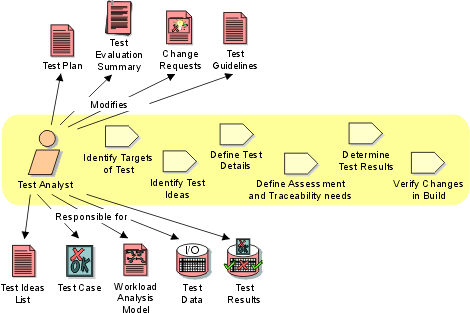Role: Test Analyst
|
The Test Analyst role is responsible for identifying and defining the required tests, monitoring detailed testing progress and results in each test cycle and evaluating the overall quality experienced as a result of testing activities. The role typically carries the responsibility for appropriately representing the needs of stakeholders that do not have direct or regular representation on the project. |
|
|
|
Description 
Roles organize the responsibility for performing activities and developing artifacts into logical groups. Each role can be assigned to one or more people, and each person can fill one or more roles. When staffing the Test Analyst role, you need to consider both the skills required for the role and the different approaches you can take to assigning staff to the role.
In some development cultures, this role is referred to as the Test Designer, or considered a specialization of the Tester role.
Related Information 
This section provides links to additional information related to this role.
- Concept: Performance Testing
- Concept: Quality Dimensions
- Concept: Test Automation and Tools
- Concept: Test-Ideas Catalog
Staffing

Skills
The appropriate skills and knowledge for the Test Analyst role include:
- good analytical skills
- a challenging and inquiring mind
- attention to detail and tenacity
- understanding of common software failures and faults
- knowledge of the domain (highly desirable)
- knowledge of the system or application-under-test (highly desirable)
- experience in a variety of testing efforts (desirable)
This role is primarily responsible for:
- Identifying the Target Test Items to be evaluated by the test effort
- Defining the appropriate tests required and any associated Test Data
- Gathering and managing the Test Data
- Evaluating the outcome of each test cycle
Role assignment approaches
The Test Analyst role can be assigned in the following ways:
- Assign one or more test staff members to perform both the Test Analyst and Tester roles. This is a commonly adopted approach and is particularly suitable for small teams and for any sized test team where the team is made up of an experienced group of Testers of relatively equal skill level.
- Assign one or more test staff members to perform the Test Analyst role only. This works well in large teams, particularly in situations where there are domain experts who have minimal test implementation experience but who have significant domain knowledge to specify appropriate tests and determine the appropriate results for those tests. This role assignment strategy is also useful to separate responsibilities when some of the test staff have minimal test automation experience and would have difficulty filling the Tester and Test Designer roles.
- Assign one staff member to perform both the Test Analyst and Test Manager roles. This strategy is another option for small to mid-sized test teams. You need to be careful that the minutia of the Test Analyst role does not adversely effect the responsibilities of the Test Manager role. Mitigate that risk by assigning less critical Test Analyst tasks to a person filling both these roles, leaving the most important tasks to team members without any direct management responsibility.
- Assign one or more staff members to perform both the Test Analyst and Requirements Specifier roles. This strategy is another option for small to mid-sized test teams, and is often used where domain experts are available to play both roles. You need to be careful that appropriate effort is devoted to satisfying both of these roles.
Note also that specific skill requirements vary depending on the type of testing being conducted. For example, the skills needed to successfully analyze the requirements for system load testing are different from those needed for analyzing system functional testing requirements.
Further Information
We recommend reading Kaner, Bach & Pettichord's Lessons Learned in Software Testing [KAN01], which contains an great collection of important considerations for test teams. Of special interest to the Test Analyst role are the chapters on the Role of the test group, Thinking like a tester, Test planning and strategy and Bug advocacy.

